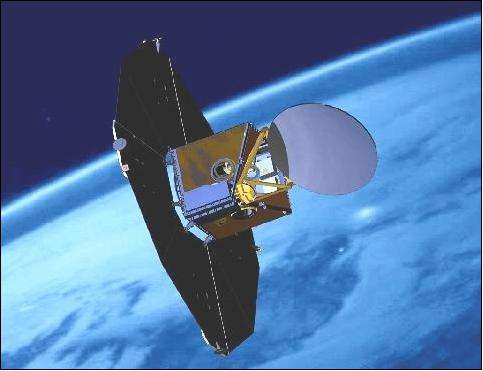January 16, 2017 report
Small long-serving satellite observes ammonia emission from the center of our galaxy

(Phys.org)—Completing its 16th year in orbit, a small Swedish astrophysics and aeronomy satellite named "Odin" has proven that it is still capable of carrying out important observations of space. The spacecraft has lately observed ammonia (NH3) emissions from an astronomical radio source known as Sagittarius A* (Sgr A* for short) at the center of the Milky Way galaxy. The results of these observations were published January 10 in a paper available on arXiv.org.
Odin was launched on February 20, 2001 with the aim of studying the depletion of the ozone layer in the atmosphere and searching for water and oxygen in interstellar space. With a mass of about 250 kilograms, the spacecraft has dimensions of 2.0 x 1.1 meters (3.8 meters when fully deployed in orbit). The satellite is equipped with an advanced radiometer using a 1.1-meter telescope and a spectrograph, called the Optical Spectrograph and Infrared Imaging System (OSIRIS).
Odin was originally designed to be operational for about two years, but the spacecraft is still in good health and is currently functioning nominally. During the astrophysics part of its mission, the satellite has observed water in comets and detected molecular oxygen in interstellar clouds. Now, a team of Swedish researchers that includes Odin mission scientists has presented new results proving that the spacecraft can still conduct significant detections.
"Recently, Odin has made complementary observations of the 572 GHz NH3 line towards the Sgr A +50 km s−1 cloud and circumnuclear disk (CND). (...) Significant NH3 emission has been observed in both the +50 km s−1 cloud and the CND. Clear NH3 absorption has also been detected in many of the spiral arm features along the line of sight from the sun to the core of our galaxy," the scientists wrote in the paper.
The observations were carried out in April 2015 and April 2016 as part of a larger survey studying the Sagittarius A complex radio source consisting of Sgr A*, the supernova remnant Sagittarius A East and the spiral structure Sagittarius A West.
According to the paper, the spacecraft detected a very large velocity width (80 km s−1) of the ammonia emission associated with the shock region in the southwestern part of the CND. The researchers propose that it may suggest a formation scenario similar to that of gas-phase water in shocks and outflows.
"The very high gas-phase water abundance determined for the shock region at CND SW by Karlsson et al. (2015) is similar to that found in the red-ward high-velocity wings of the Sgr A molecular clouds, and likely results from shock heating causing release of pre-existing grain surface water, possibly combined with high temperature shock chemistry," the paper reads.
The authors concluded that the high-quality spectra obtained by Odin clearly demonstrate the satellite's continuing capabilities. It shows that it is possible to build a comparatively cheap, but complicated spacecraft that can remain in high quality operation for a long mission lifetime.
More information: Odin observations of ammonia in the Sgr A +50 km/s Cloud and Circumnuclear Disk, arXiv:1701.02536 [astro-ph.GA] arxiv.org/abs/1701.02536
Abstract
Context. The Odin satellite is now into its sixteenth year of operation, much surpassing its design life of two years. One of the sources which Odin has observed in great detail is the Sgr A Complex in the centre of the Milky Way. Aims. To study the presence of NH3 in the Galactic Centre and spiral arms. Methods. Recently, Odin has made complementary observations of the 572 GHz NH3 line towards the Sgr A +50 km/s Cloud and Circumnuclear Disk (CND). Results. Significant NH3 emission has been observed in both the +50 km/s Cloud and the CND. Clear NH3 absorption has also been detected in many of the spiral arm features along the line of sight from the Sun to the core of our Galaxy. Conclusions. The very large velocity width (80 km/s) of the NH3 emission associated with the shock region in the southwestern part of the CND may suggest a formation/desorption scenario similar to that of gas-phase H2O in shocks/outflows.
© 2017 Phys.org





















